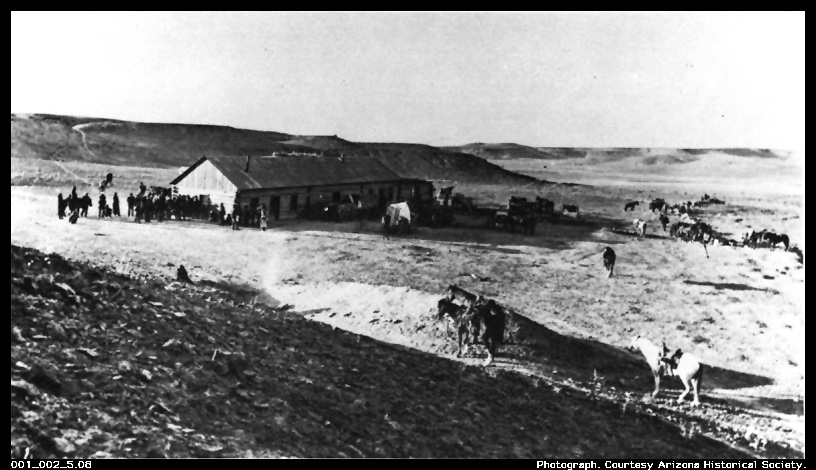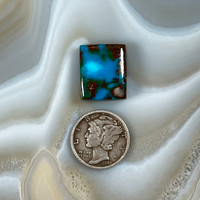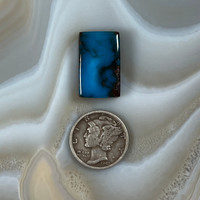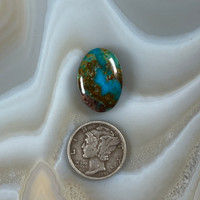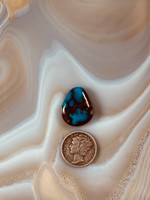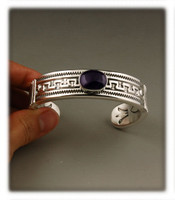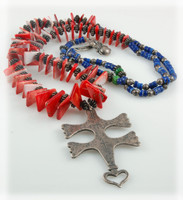 Loading... Please wait...
Loading... Please wait...- 970-375-2401
- Gift Certificates
- My Account
Currency Displayed in
- Home
- Learning Center
- Native American Facts and Native American Jewelry Information
- General Native American Silversmith Info
Categories
General Native American Silversmith Info
General Native American Silversmith Info
Native American Artists & Silversmiths
Despite their inherent love of ornamentation and jewelry, the Indians of the Southwest did not learn to work with silver until the latter part of the 19th century. Before that they acquired the few silver ornaments they owned through trade with Hispanic settlers and neighboring Plains Indians. The Plains people had acquired their silver in trade with English, French and American trappers.
--------------------------------------------------------------------------------
One of the first Native American Indian metal smiths was a Navajo known as Atsidi Sani who learned, around 1850, to form black metal from a Mexican blacksmith living in the New Mexico territory. In 1853, he was introduced to silversmithing and began creating Native American Jewelry from silver.
--------------------------------------------------------------------------------
Henry Dodge moved to a house near Fort Defiance and married a Navajo woman. Dodge brought with him a blacksmith and a Mexican silversmith. Years later, after the Navajos were released from their five-year confinement at Fort Sumner, (Bosque Redondo), Atsidi Sani came to the Indian agency to observe the two smiths at work and refine his primitive metalworking skills.
--------------------------------------------------------------------------------
Atsidi Sani taught his four sons to craft silver and they, in turn, taught others. Later, in the 1880s, J.L. Hubbell hired several Mexican silversmiths to teach the craft to Navajos at his trading post in Ganado, Arizona. The Navajos learned to cast silver in sandstone or tufa as well as produce hand-hammered work. Turquoise, a traditional favorite of the Navajos, began to be combined with silverwork in the 1880s.
--------------------------------------------------------------------------------
J.L. Hubbell capitalized on its popularity by importing Persian turquoise for trade to the Navajos. Eventually, the local supply of turquoise increased as more mines were opened in america.
--------------------------------------------------------------------------------
Originally, Navajo Native American Silversmiths made silver jewelry for themselves or for other Indians. After 1900, they began to create native american jewelry for commercial consumption as well. The availability of turquoise and silver, together with better silver working tools, enabled craftsmen to supply the growing market among Indian traders and tourists who were arriving in droves by railroad to visit the Southwest. The entry of women into the craft was another measure of its rapid commercialization. Although silversmithing had been practiced only by men, Navajo women had begun working the metal by 1918 and began to make beautiful native american jewelry.
--------------------------------------------------------------------------------
American coins were the primary source of silver for jewelry until 1890, after which defacing a U.S. coin was outlawed. Mexican pesos were substituted until 1930 when their export to the American Southwest was forbidden. Sterling silver ingots with a slightly purer silver content replaced the coins. In the 1930s, sterling silver in convenient sheets and wire forms became increasingly available from Indian traders. Today, the majority of Indian jewelry is still made using sheet and wire.
--------------------------------------------------------------------------------
Metalworking had a different history among the Zuni. In about 1830, the Zuni learned to work with copper and brass salvaged from old kettles. They did not begin silver crafting until four decades later. Around 1872, the Navajo smith Atsidi Chon, who traded frequently with the Zuni for livestock, taught a Zuni blacksmith named Lanyade the skill of silversmithing. Much of the earliest Zuni silver jewelry was essentially identical to Navajo work.
--------------------------------------------------------------------------------
Early Zuni pieces were plain, hand-wrought silver occasionally decorated with simple die-stamping or rocker engraving. Around 1890 they began to include turquoise in their work, as had their Navajo neighbors. Until about 1920, the Zuni fashioned jewelry primarily for themselves and other native peoples. By 1930, the Zuni were creating much of their jewelry for tourists. Within ten years, jewelry making had become a major source or revenue.
--------------------------------------------------------------------------------
The emphasis on small stone work and inlay work began to emerge in the 1920s, developing partly from a revival of prehistoric designs. Today, this style of jewelry, needlepoint, petit point, and inlay is most strongly associated with the Zuni jewelry making tradition.
--------------------------------------------------------------------------------
Hopi silverwork is of a more recent vintage than Navajo or Zuni. Early Hopi jewelry was made from natural materials, turquoise, shell, wood, and seeds. Silver working was introduced to the Hopi around 1890 when the Zuni smith Lanyard began to trade some of his silver jewelry among the Hopi, apparently in return for hand-woven native cotton textiles.
--------------------------------------------------------------------------------
Lanyade eventually taught his craft to a Hopi named Sikyatala. Early hand wrought silver beads, rings, and bracelets made by the Hopi are virtually indistinguishable from those made by Zuni and Navajo smiths. Some Hopi created cast silverwork, as well. But it was not until the 1930s that a distinctive Hopi style emerged, and it developed only with non-native encouragement.
--------------------------------------------------------------------------------
In 1938 Dr. Harold Colton and his wife Mary Russell Colton of the Museum of Northern Arizona initiated a project encouraging Hopi silversmiths to create a unique type of jewelry that would be instantly recognized as Hopi.
--------------------------------------------------------------------------------
The result, silver overlay, is today the most widely recognized type of Hopi silverwork. Using designs drawn from traditional pottery, textiles and baskets, Hopi smiths soldered together two sheets of silver after cutting out designs in the top layer so that the under layer is visible. The under layer is blackened or oxidized and usually textured with chisel marks or stamp work. Turquoise, coral, and other materials occasionally have been set in Hopi overlay jewelry, but for the most part, the elegant silver overlay has stood alone.
--------------------------------------------------------------------------------
Through the 20th century, Southwestern Indian jewelry gradually diverged into clearly recognizable styles associated with Navajo, Zuni, Hopi and Rio Grande pueblos. Today, these distinctions have again begun to blur as native artisans, inspired by pioneering artists like Charles Loloma, James Little, Lee Yazzie and Preston Monongye, redefine the tradition and move toward a contemporary, more universal style of 'new Indian' jewelry.
Also See: The Fort Defiance Story
Also See: The Chilchimbito Story
Also See: IndianVillage.com
